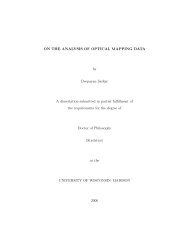Struggles with Survey Weighting and Regression Modeling paper
Struggles with Survey Weighting and Regression Modeling paper
Struggles with Survey Weighting and Regression Modeling paper
Create successful ePaper yourself
Turn your PDF publications into a flip-book with our unique Google optimized e-Paper software.
154 A. GELMAN<br />
FIG. 1. The proportion of adults surveyed who answered yes in<br />
the Gallup Poll to the question, “Are you in favor of the death<br />
penalty for a person convicted of murder?” among those who expressed<br />
an opinion on the question. Itwouldbeinterestingtoestimate<br />
these trends in individual states.<br />
divided by the proportion who will support the Republican;<br />
it is straightforward to move from estimating a<br />
population mean to estimating this ratio, as discussed<br />
in the context of this example by Park, Gelman <strong>and</strong><br />
Bafumi (2004)]. We would also like to use series of<br />
national polls to estimate state-by-state time trends, for<br />
example in the support for the death penalty over the<br />
past few decades. (See Figure 1 for the national trends.)<br />
For the Social Indicators <strong>Survey</strong>, we are interested in<br />
population average responses to questions such as, “Do<br />
you rate the schools as poor, fair, good or very good?”,<br />
average responses in subpopulations (e.g., the view of<br />
the schools among parents of school-age children), <strong>and</strong><br />
so-called “analytical” studies that can be expressed in<br />
terms of regressions (e.g., predicting total satisfaction<br />
given demographics <strong>and</strong> specific attitudes about health<br />
care, safety, etc.). In this article, we focus on trends<br />
from 1999 to 2001, as measured by changes in two<br />
successive Social Indicators <strong>Survey</strong>s, on a somewhat<br />
arbitrary selection of questions chosen to illustrate the<br />
general concerns of the survey.<br />
Table 1 shows the questions, the estimated average<br />
responses in each year, <strong>and</strong> the estimated differences<br />
<strong>and</strong> st<strong>and</strong>ard errors as obtained using two different<br />
methods of inference. This <strong>paper</strong> is centered on the<br />
puzzle of how these two estimation methods differ. We<br />
shall get back to this question in a moment after reviewing<br />
some basic ideas in survey sampling inference.<br />
1.2 Poststratification <strong>and</strong> <strong>Weighting</strong><br />
Naive promulgators of Bayesian inference—or the<br />
modeling approach to inference in general—used to<br />
say that the method of data collection was irrelevant<br />
to estimation from survey data. All that matters, from<br />
this slightly misguided perspective, is the likelihood, or<br />
the model of how the data came to be. However, as has<br />
been pointed out by Rubin (1976), the usual Bayesian<br />
or likelihood analysis implicitly assumes the design<br />
is “ignorable,” which in a sampling context roughly<br />
means that the analysis includes all variables that affect<br />
the probability of a person being included in the<br />
survey (see Chapter 7 of Gelman et al., 2004, forareview).<br />
In a regression context, the analysis should include,<br />
as “X variables,” everything that affects sample selection<br />
or nonresponse. Or, to be realistic, all variables<br />
should be included that have an important effect on<br />
sampling or nonresponse, if they also are potentially<br />
predictive of the outcome of interest. In a public survey<br />
such as the CBS polls, a good starting point is the set<br />
of variables used in their weighting scheme: number<br />
of adults <strong>and</strong> number of telephone lines in the sampled<br />
household; region of the country; <strong>and</strong> sex, ethnicity,<br />
age <strong>and</strong> education level of the respondent (see<br />
Voss, Gelman <strong>and</strong> King, 1995). For the Social Indicators<br />
<strong>Survey</strong>, we did our own weighting (Becker, 1998)<br />
TABLE 1<br />
Weighted<br />
averages<br />
Question 1999 2001<br />
(a) time<br />
change<br />
in<br />
percent<br />
(b) linear<br />
regression<br />
coefficient<br />
of time<br />
(a) time<br />
change<br />
on logit<br />
scale<br />
(b) logistic<br />
regression<br />
coefficient<br />
of time<br />
Adult in good/excellent health 75% 78% 3.4% (2.4%) 6.6% (1.4%) 0.19 (0.13) 0.48 (0.10)<br />
Child in good/excellent health 82% 84% 1.7% (1.5%) 1.2% (1.3%) 0.24 (0.21) 0.18 (0.20)<br />
Neighborhood is safe/very safe 77% 81% 4.5% (2.3%) 4.1% (1.5%) 0.27 (0.14) 0.27 (0.10)<br />
Estimates for some responses from two consecutive waves of the New York City Social Indicators <strong>Survey</strong>, <strong>and</strong> estimated changes, <strong>with</strong><br />
st<strong>and</strong>ard errors in parentheses. Changes are estimated in percentages <strong>and</strong> on the logit scale. In each scale, two estimates are presented: (a)<br />
simple differences in weighted means <strong>and</strong> (b) regression controlling for the variables used in the weighting. Approaches (a) <strong>and</strong> (b) can give<br />
similar results but sometimes are much different.
















